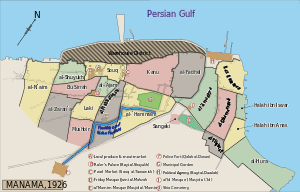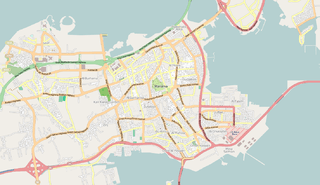Noaim
Noaim or Al-Noaim (Arabic: النعيم; an-No'aim) is one of the neighborhoods of Bahrain's capital Manama, located in the northwest of Manama city center.[1] And due to its urban expansion, its population and geography, and because of historical conditions, it has become its own district.

The population of Noaim is about 6,000 people living in the area currently, while more than ten thousand people live in different areas and villages of Bahrain. While some of the displaced families have been cut off from the area, the majority have remained in contact with their families, relatives and friends who are still living in the area. These visits intensify in religious occasions such as holidays, Ashura and Ramadan.
One of the most important reasons for the isolation of the Noaim from Manama is the construction of the wall of Manama,[2] which divided the neighborhood of Noaim into two parts: the southern Noaim and was within the fence, and the northern clouds were outside the fence, and because most of the people of Noaim were engaged in the character associated with the sea as a shipbuilding and pearl trade and fishing, A large part of the inhabitants of the southern Noaim are outside the fence. Thus the area of Noaim is separate from Manama. Today, this wall is no longer in existence, where its traces have disappeared for decades, and the urban link between Al Noaim and Manama neighborhoods has returned.
History of Al-Noaim
The history of the neighborhood is generally vague, except for the last century, because most of the history of the region is not documented, and only the oral narration of the events transmitted by some generations is lost, while most of it is lost in the folds of the past
Identity and the Origin
According to the elders of the village, the origin of the name of the village of "Noaim" is that it was a good land, and it is a bliss for its people, who were the nukhazah(ship captains) and merchants of pearls. Therefore, its name is derived from the word "noaim" it was famous for the beauty of nature and its proximity to the rich sea of riches ... in the past.
This good village, like all the villages of Bahrain, does not give up its authentic Bahraini identity, although it remains steadfast among the "outsiders" ... where thousands of migrant workers live, but "Noaim" that its people see is a source of pride and honor. Of the political events, especially in the fifties day witnessed the meetings and meetings of the National Union and one of its sons, the late Mr. Ali Kamal al-Din, one of the eight members in addition to the symbols: Mohsen Trader, Ibrahim bin Musa, Abdullah Abu Dheb, Abdali Alawiwat, Abdulaziz Shamlan, Ibrahim Fakhro , And Abdul Rahman Al Baker, a body that It had to deal with the sectarian differences that were gnawing at the body of society in Bahrain during 1953 and 1954, where it was born as a unified national front to demand political reforms in the administrative apparatus and the judiciary and the election of a representative People's Assembly.
Modern Events
The last century was the best in terms of documenting the events of the region, where in 1930 a clinic was built in Manama in the area, and was the nucleus of the hospital later, where it began in the establishment in 1940 on land was originally an old house owned by Abdul Aziz al-Gosaibi , Noaim Hospital is the first public hospital built on the land of Bahrain.
In 1953, the Noaim Cultural and Sports Club was established. Its first decades were marked by cultural, political and sporting activity. The club's activities in the past two decades were limited to sports activities, especially in handball. The club achieved a number of achievements at the national level. In 2001, after extensive integration, the club was merged with a number of clubs in the capital under the name of Al Shabab Club. The Noaim Cultural Center was established to serve the people of the region on the cultural side.
In the 1950s, Noaim was one of the active centers of the movement. The reformist demands that emerged between 1954 and 1956. Mr. Ali ibn al-Sayyid Ibrahim Kamal al-Din al-Ghuraifi (a religious scholar and one of the symbols of the region at that time) was among the eight people elected by the people to represent him in what was historically known as the National Union .
In 1963, the State established the Al-Naeem Secondary School for Boys and was located directly on the seashore. Graduates from this school graduated from different villages in Bahrain and in particular the villages of the northern governorate. The School was a politically active school through its Fifty-year history, What called demonstrations and sit-ins in solidarity with national and national issues. The neighborhood witnessed the construction of a number of other schools, including a primary school for girls that was adjacent to the western orphanage. It was replaced by another school, Sumaya School, located south of the cemetery, and a primary school for boys west of the area called Ibn Khaldun School. Which is located in the area of Sweifieh west of Noaim.
The decades of the 1970s and 1980s witnessed the emergence of the phenomenon of mass exodus of the region's families to housing in the housing projects established by the ministry of housing in some areas of Bahrain. The region did not promote housing schemes despite the vast area that was filled from the sea north of the region. Construction of a number of commercial complexes, malls, central markets and hotels.
Notable residents
References
- Al Noaim Archived 2017-09-27 at the Wayback Machine.
- "Manama 'Wall' incident" (PDF). Alwasat News. 25 May 2009. Retrieved 22 June 2019.
- المحلية, النعيم-محرر الشئون. "قرية "النعيم"... من الجميـلة الزاهرة إلى "الصامدة" بين الغرباء". صحيفة الوسط البحرينية (in Arabic). Retrieved 2019-06-22.
